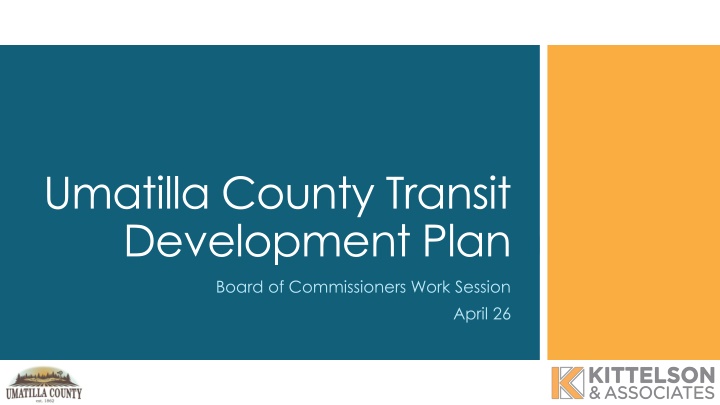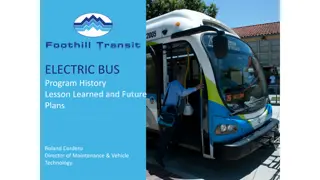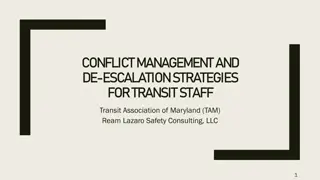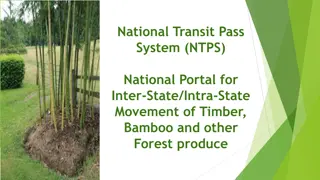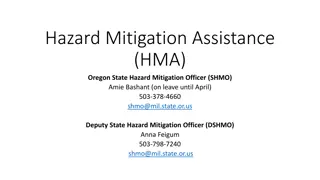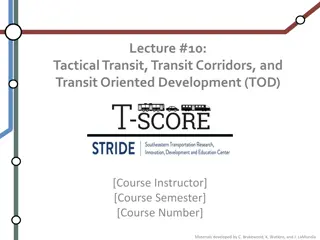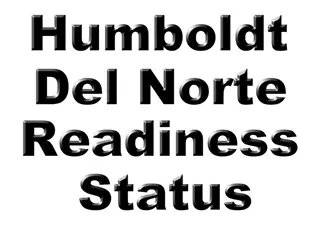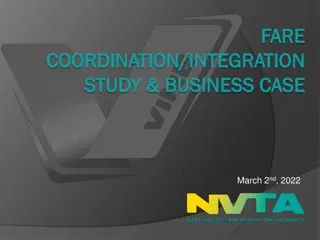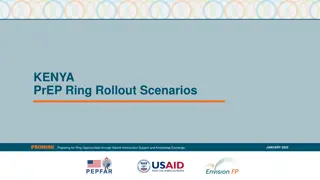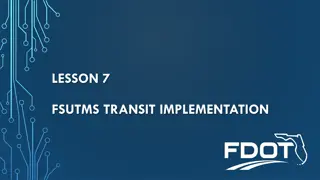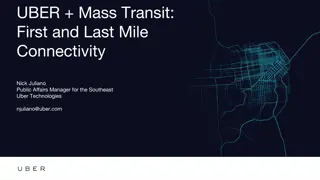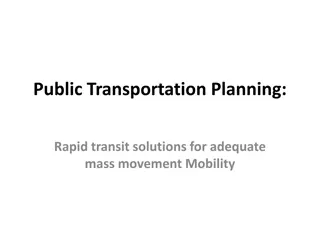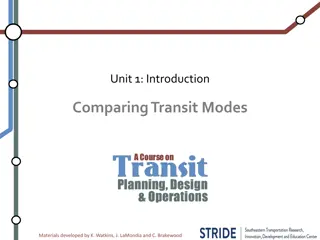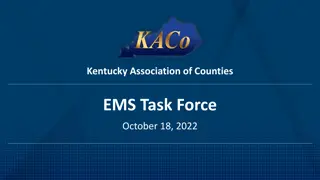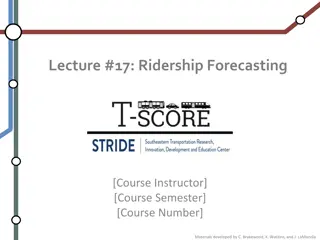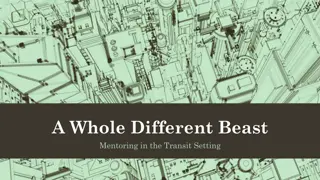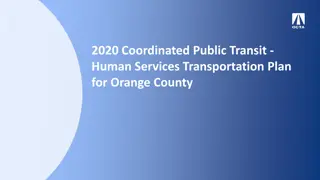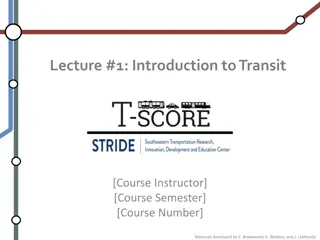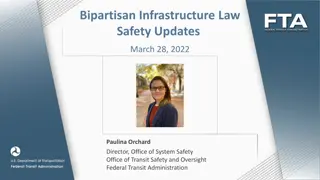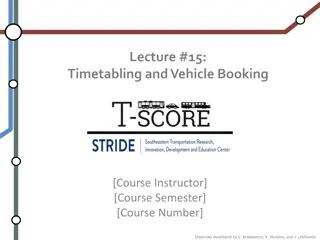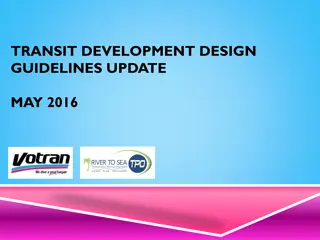Transit Development Plan Overview for Wasco and Umatilla Counties
This document outlines the Transit Development Plans (TDP) for Wasco and Umatilla Counties, focusing on project management, needs assessment, financial cost estimates, implementation plan, public participation, and adoption timelines. It compares executive summaries, history, future vision, baseline conditions, service opportunities, funding forecasts, prioritization, and next steps. The key milestones highlight the development of transit providers and emphasize the governance needs for Umatilla County considering HB2017/STIF.
Download Presentation

Please find below an Image/Link to download the presentation.
The content on the website is provided AS IS for your information and personal use only. It may not be sold, licensed, or shared on other websites without obtaining consent from the author.If you encounter any issues during the download, it is possible that the publisher has removed the file from their server.
You are allowed to download the files provided on this website for personal or commercial use, subject to the condition that they are used lawfully. All files are the property of their respective owners.
The content on the website is provided AS IS for your information and personal use only. It may not be sold, licensed, or shared on other websites without obtaining consent from the author.
E N D
Presentation Transcript
Wasco County Transportation Development Plan October 29, 2020 Board of Commissioners Work Session Umatilla County Transit Development Plan April 26
Welcome, Meeting Purpose, Agenda Review Project Overview Transit Development Plan and Executive Summary Overview Discussion Next Steps 2
The Transit Development Plan (TDP) will: Project Overview Consider fixed- route, demand- response, and intercommunity services Consider capital investments, infrastructure, and technologies to support services Provide a strategic and coordinated vision for transit service 3
2022 1 - Project Management and Project Kick-Off Spring/Summer AC #1 2 Needs Assessment Summer AC #2 Project Tasks and Schedule Project Tasks and Schedule 3 Financial Cost Estimates, Implementing Options, and Outcomes Summer/Fall AC #3 4 Implementation Plan Fall/Winter AC #4 5 Public Participation Documentation Late Spring AC #5 6 Transit Development Plan and Adoption Late Spring 2023 BOC 4
CONTENT COMPARISON Executive Summary Transit Development Plan History and Future of Transit in Umatilla County Project Purpose, Process, and Public Involvement Vision and Goals History and Future of Transit in Umatilla County Project Purpose, Process, and Public Involvement Vision and Goals Baseline Conditions (Existing Services Only) Baseline Conditions Transit Needs and Markets Future Service Opportunities Funding Forecasts Funding Summary and Prioritization Implementation Plan Next Steps Transit Needs and Markets Future Service Opportunities Funding Forecasts Prioritization Implementation Plan Next Steps 5
Key milestones and context of how the transit providers developed themselves and their services over time The role of Umatilla County considering HB2017/STIF Highlight of coordination and governance needs History and Future of Transit Of particular need for the County is an evaluation of governance options that resolve jurisdictional barriers and reporting redundancies and bolster economies of scale while maintaining local decision-making autonomy. 6
Existing and Future Needs Assessment Vision and Goals Project Process Service Opportunities and Timelines Implementing Options and Outcomes 7
Project Webpage: provides information about the project, schedule, and technical memoranda Stakeholder Outreach Events: includes discussions with key stakeholders in the project area to better understand the needs of the public Online/On-board Survey: used to determined how and where people use transit services, gather thoughts about proposed modifications to existing and proposed transit routes, and gain an understanding of the public s transportation priorities and preferences Public Involvement Process Advisory Committee: reviews and provides feedback on technical memoranda and the draft TDP and represents ODOT, local cities, and community members Board of Commissioners and Umatilla County Transportation Advisory Committee (UCTAC): reviews and provides recommendations before adopting the final TDP 8
Provide an equitable, safe, convenient, and coordinated transit network throughout Umatilla County that will support the health and well-being of Individuals, communities the economy and the environment. Equity Health and Safety Mobility, Sustainability Coordination Information, Marketing, and Technology Connectivity, and Convenience Vision and Goals 9
Existing Services Highlights fixed-route and dial-a-ride services across the County with most- recent year of ridership 10
Provide additional or modified service in Hermiston and Pendleton Expand service to neighboring regions, especially the Tri-Cities in Washington and Boardman area in Morrow County Needs Summary Modify service between Umatilla County and the Walla Walla area Increase regional/long-distance service Serve growing populations inside Urban Growth Boundaries (UGBs) and large cities 11
Enhance access for transit-dependent populations in rural and urban areas Increase service frequency, extend service hours, and provide weekend service Needs Summary (Continued) Improve education, marketing, and partnerships Update vehicle fleet Improve bus stop amenities and access Update tools and technology 12
Short-term projects: high priority, lower implementation costs or dedicated funding in- place, higher ridership potential and improved transit access oPursueSTIF Intercommunity funds and WSDOT grants (via Ben Franklin Transit) to pilot the proposed Tri-Cities route. oImplement passenger counters and monitor stop usage to assess bus stop amenityneeds. oImproveamenitiesat the Pendleton Walmart, Hermiston Walmart, Til Taylor Park, 3rd & Orchard (or alternative Hermiston transit center), and Nixyaawii Governance Center/Tribal Health Center stops. oPursue real-time vehicle arrival implementation and associated trip planner updates. Prioritization 13
Mid-term projects: consider public feedback on service enhancements, cost constraints, and service distribution across the county o Pursue additional funding to implement service enhancements and maintain existing operations; consider becoming a transportation district and pursuing property tax revenues and/or increasing city contributions. o Becoming a transportation district may result in provider consolidation with potential to pool staffing and decrease overhead costs in providing service. o Before or alongside this transition, providers could pursue a centralized transit center in Pendleton, potentially using and/or expanding the planned storage facility in northwest Pendleton. o After a storage facility transition, the Mission Metro Alternative A could be implemented to serve as an express connection between Mission and Pendleton. o Additional revenues could be used to add one trip per weekday to Hermiston HART, La Grande Arrow, and Pilot Rocket. o Pursue lower emission vehicles and infrastructure to lower operating costs and reduce greenhouse gas emissions. Prioritization 14
Long-term projects: highly desired by riders but would require substantial additional funding that may be difficult to obtain in the short- or mid-term. oPursuing increased funding to implement increased and new weekend service on all fixed-routes and demand-response services. Prioritization Unconstrained projects: high priority for survey respondents but beyond projected funding availability oIncreased weekend service and increased frequency for all fixed-routes and demand- response services. 15
Capital and Infrastructure Plan: provides a programmatic approach to support transit operations with rider amenities and infrastructure Staffing Management, Marketing, and Information Plan: helps publicize and encourage people to use transit Governance: presents coordination opportunities, staff commitments, costs, and benefits based on specified concepts and considerations System Performance Monitoring: enables a dynamic system where service adjustments can be implemented and justified following performance evaluations Considerations: considers additional staffing needed over time as service increases Implementation Plan 16
How well do these recommendations meet your expectations for transit service in the county? What implementation considerations should be added or modified? Discussion Do you have other thoughts or questions for the TDP? 17
oThe project team will revise the TDP and Executive Summary based on input from AC (April 12th), UCTAC (April 19th), and Board of Commissioners feedback oUCTAC will review the revised documents and consider recommendation to the Board of Commissioners on May 17th oThe TDP and Executive Summary will be presented for adoption June 7th oTDP will guide transit investments in the County and adapt to shifting needs, funding opportunities, and partnerships Next Steps 18
